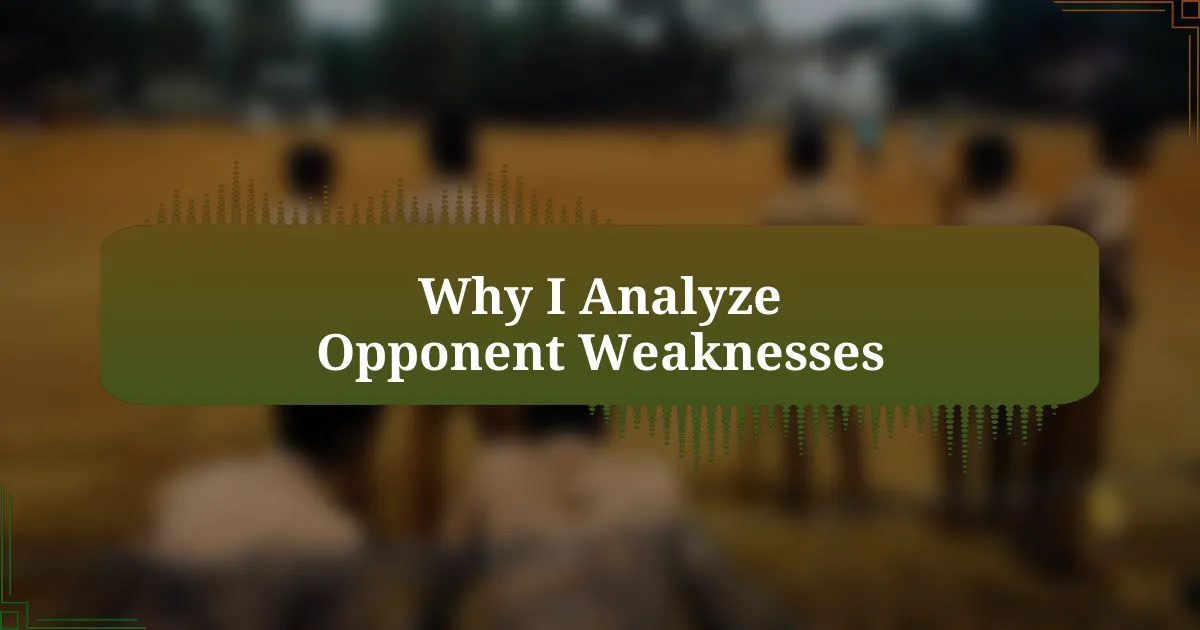Key takeaways:
- Understanding and exploiting an opponent’s weaknesses can significantly enhance game performance and boost confidence.
- Developing and adapting strategies is essential in cricket, as flexibility can neutralize threats and leverage opportunities.
- Using tools like video analysis and statistical data helps uncover insights that can inform strategic decisions during matches.
- Personal experiences and insights from teammates can provide valuable information that may shift the game’s outcome.
Author: Evelyn Harper
Bio: Evelyn Harper is an award-winning author known for her evocative storytelling and rich character development. With a background in psychology, she weaves intricate narratives that explore the complexities of human relationships. Her debut novel, “Whispers in the Wind,” received critical acclaim and established her as a fresh voice in contemporary fiction. A graduate of the Iowa Writers’ Workshop, Evelyn resides in Portland, Oregon, where she continues to write and inspire aspiring authors through workshops and mentorship. When not immersed in her writing, she enjoys hiking the Pacific Northwest trails and sipping coffee at local cafes.
Understanding opponent weaknesses
Understanding opponent weaknesses is like discovering a hidden map on the cricket field. During my early days as an amateur cricketer, I vividly remember the thrill of facing a bowler known for his speed, only to find that he struggled with length. This realization not only boosted my confidence but reinforced the importance of observing my opponent’s patterns to exploit their limitations.
Have you ever noticed how a batter’s footwork can reveal their uncertainty? I’ve experienced matches where a player’s inability to adjust their stance against spin was apparent. It became my mission to target that flaw, and watching their discomfort made the game even more exhilarating. Analyzing these vulnerabilities, rather than merely focusing on my game, allowed me to approach batting with a strategic mindset, transforming the way I played.
Reading the field and picking up on subtle cues can make all the difference. I’ve found that during warm-ups, players often expose their weaknesses—be it tired arms or shaky hands. Realizing this can turn the tides in a match. It’s almost like a game within a game, where knowing your opponent’s strengths and weaknesses gives you an edge that can lead to victory. And isn’t that what we’re all after?
Importance of strategy in cricket
Strategy in cricket is crucial because it transforms the game from mere athleticism into a battle of wits. I recall a particular match where my team devised a plan to counteract a seasoned spinner. Instead of merely reacting to his deliveries, we decided to focus on scoring aggressively in the first few overs. This calculated approach not only unsettled him but also set the tone for our innings, highlighting how strategic thinking can dictate the flow of the game.
It’s fascinating to see how adaptability within this strategy is essential. I learned this firsthand while captaining my local team. In one game, an opponent’s fast bowler began to dominate our batting lineup. Instead of sticking to our original plan, we quickly adjusted our strategy, encouraging players to play defensively and focus on rotating the strike. This shift not only neutralized his threat but also instilled a sense of calm within the team, showcasing that strategy is as much about flexibility as it is about planning.
Moreover, the emotional aspect of executing a solid strategy cannot be underestimated. I vividly remember feeling a surge of excitement when our plans started to pay off. The buzz in our dugout as a player executed the strategy perfectly created an environment of trust and teamwork. Isn’t it amazing how a shared strategy can unite players, making each victory feel like a collective achievement rather than an individual effort?
Benefits of analyzing weaknesses
Analyzing an opponent’s weaknesses can significantly enhance your performance. I remember a match where I focused on a bowler’s tendency to overpitch. By patiently waiting for those deliveries, I capitalized on easy boundaries. This awareness transformed my approach, allowing me to play more aggressively and score freely. Isn’t it rewarding when strategic insights directly contribute to personal success on the field?
Additionally, understanding your opponent’s weaknesses fosters a sense of confidence. When I identified vulnerabilities in the batting order of an opposing team, I felt empowered to suggest field placements that exploited those gaps. That realization not only motivated me but galvanized the entire team, creating a winning mentality. Have you ever noticed how a single strategic insight can elevate the spirits of a team?
Lastly, this analysis helps you anticipate and react better during the game. In one memorable match, recognizing a key batsman’s struggle against spin made all the difference. I advised my captain to introduce our best spinner sooner than planned. The batsman eventually fell prey to a well-timed delivery. This experience reinforced my belief that a thoughtful examination of weaknesses leads to strategic advantages and can dramatically shift the game in your favor.
Tools for analyzing opponent weaknesses
When it comes to analyzing opponent weaknesses, I find that video analysis is an invaluable tool. I often spend hours reviewing match footage, noting how bowlers deliver their best balls and where they falter. It’s fascinating how a single replay can reveal so much—like that bowler who consistently strays off-target under pressure. Have you ever watched a match replay and found insights that completely changed your game plan?
Another effective method I’ve employed is statistical analysis. By crunching the numbers from previous matches, I can detect patterns in an opponent’s performance. For instance, I once calculated that a certain batsman struggled against fast, short-pitched balls. Armed with this info, I advocated for a bouncer-heavy strategy, and it paid off big time. Have you ever found a surprise weakness in a player that turned the game around?
Lastly, engaging in conversations with teammates can lead to discovering weaknesses that might not be immediately apparent. I vividly recall a chat with a teammate who had previously played against a specific opponent. His insights about that player’s mental blocks when under pressure were gold. Don’t you think that combining personal experiences and collective knowledge can provide a more rounded understanding of whom you’re up against?
Personal experiences with opponent analysis
Reflecting on my journey, I remember a particular match where I decided to dive deep into analyzing our opponents’ weaknesses. We were up against a team known for their formidable batting lineup, yet as I studied their past performances, I noticed several of their key players had a tendency to struggle against spin bowling. This realization gave me a surge of confidence, as I felt I had a strategy that could unsettle them. Have you ever felt that rush when you discover a potential edge over your rivals?
There was a game a few seasons back that truly highlighted the importance of understanding an opponent. After pinpointing that one of their bowlers had a weak spot when facing aggressive batting, I volunteered to open the innings. Each ball bowled by him felt like an opportunity. As I scored runs off him, I could sense their frustration building. Have you ever seen the tide turn directly because of a calculated approach based on analysis?
A memory that stands out involves a tense chat before a crucial match. During warm-ups, my teammate, who had faced a specific bowler before, shared how the bowler tended to lose focus after a few overthrows. This nugget of knowledge transformed my mindset. Knowing I could exploit that flaw made me approach my innings with determination. How often do you think insights like these can define the outcome of an important game?
Impact on my game performance
Analyzing my opponents has profoundly impacted my game performance. I vividly recall a match where I noticed their number three batsman consistently struggled against deliveries that turned in. Armed with this knowledge, I adjusted my field placements to apply pressure on him. As I saw the ball pitch and turn, I felt a thrill witnessing my analysis pay off with a crucial wicket. Isn’t it amazing how knowing just one weakness can change the course of a game?
In another instance, I approached a fiercely competitive match against a team famous for their pace attack. During practice sessions, I honed my skills against quick bowling, but understanding their bowlers’ habits was key. By identifying that one bowler often bowled too short, I concentrated on my pull shot. When he finally bowled that predictable delivery, I hit it for six. In that moment, I felt an exhilarating rush of validation. Has a single moment like this ever empowered your play?
Finally, I can’t help but reflect on how anticipation influences my overall confidence. Preparing for a game, I often remind myself of my past successes in exploiting opponent weaknesses. This mindset shift means I’m not just hoping to perform well; I’m stepping onto the field with a game plan. This surge in confidence impacts every aspect, from my batting stance to my fielding focus. Do you remember a time when confidence transformed your approach to competition?



